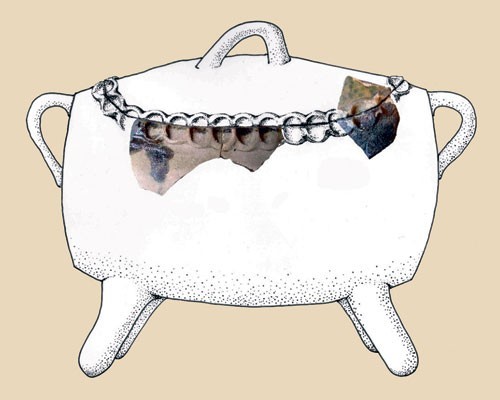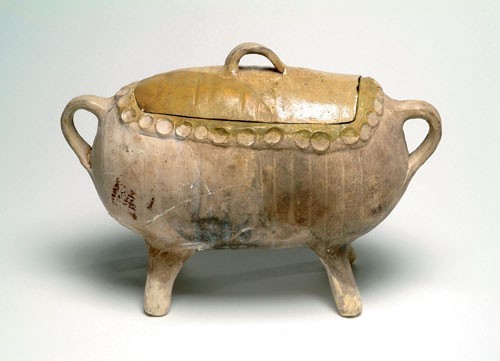
Schweinetopf sherds, Surrey-Hampshire, England, early seventeenth century. Border ware. (Illustration, Caroline Taylor.) These sherds, superimposed on a drawing of the form, were found during recent archaeological excavations at Jamestown, Virginia.

Schweinetopf, Surrey-Hampshire, England, second half of the sixteenth century or early seventeenth century. Border ware. H. 9". (Courtesy, Museum of London collections; photo © Museum of London.)

After Joachim Wtewael (1556–1638), Kitchen Scene with a Parable of a Feast. Oil on canvas. 24 3/4" x 39 3/8". (Courtesy, Réunion des Musées Nationaux, Louvre, Paris/Art Resource, N.Y.; photo, Gérard Blot). A Schweinetopf sits on a table in this busy kitchen, where fish and meat are being prepared for a feast.
“I know exactly what it is!” proclaimed Jacqui Pearce, ceramics specialist with the Museum of London, following my description of a perplexing ceramic find from the Association for the Preservation of Virginia Antiquities archaeological excavations at Jamestown, Virginia, the English settlement established in 1607. We were standing in her office at the Mortimer Wheeler House in north London. The next moment we were dashing down the hall to the cavernous storage bay of the London Archaeological Archive and Research Center (LAARC) that holds the visual storage cabinets of glass and pottery from decades of London-area excavations. Jacqui unlocked a cabinet and pulled out a small, rotund, lidded pot with four legs. “Yes!” I exclaimed with excitement, as I recognized the thumbed rim of a thin whiteware vessel with unusual throwing rings running vertically to the opening, just as I had seen on our sherds (fig. 1).
The sherds found at Jamestown are from a barrel-shaped vessel known as a Schweinetopf, or “pig pot,” almost certainly because of its porcine appearance. As indicated by its name, the form, which originated in sixteenth-century Germany, is known as a Bräter, or roasting pot. Thrown in the shape of a bottle, with a flat bottom and rounded sides, the vessel has two splayed feet applied to each side, enabling it to be set upon the hearth. An ovoid opening is cut on the side of the vessel opposite the feet, which explains the strange orientation of the throwing rings. Covered by a handled lid, the rim is reinforced with an additional thumb-impressed strip of clay, which on some of the vessels (including the Jamestown example) had been applied before the lid was cut out.
While later forms of the Schweinetopf are flat on each side (the top and bottom of the bottle), early forms of the vessel maintain the bottle’s narrow neck, although whether the neck is an actual opening or just residual is not clear.[1] If it was maintained as an opening, and perhaps closed by a cork, it could have been used to drain liquids from the meat as it cooked.
Jamestown’s Schweinetopf, made in the fine whiteware fabric of the English Surrey-Hampshire Border ware potters, appears to be the first of its kind found in America. It has been burned, probably during use, leaving its interior glaze a reduced purple-brown. Based on a glazed fragment of unburned lid that fit onto the vessel rim, it once sported a green lead glaze.
The form has just recently been recognized among kiln waste in Farnborough Hill, Hampshire, that was first excavated by Felix Holling between 1968 and 1972 (fig. 2).[2] Subsequent archaeological research in this area has revealed that several kilns were in production during the second half of the sixteenth and into the early seventeenth centuries. One of these manufacturing sites most likely was the source of the Jamestown Schweinetopf.
In Germany and the Netherlands the Schweinetopf form is made in Hafner ware, a lead-glazed white earthenware typical of the Lower Rhineland and very similar to the Border ware clays. The term Hafner (German for “potter”) generally has been applied to the whitewares produced in the southern and middle Rhine area. The refined white clays, which are the same as those used in the production of tobacco pipes, are so similar all through this area that it is very diffcult to ascribe wares to specific kiln sites.[3] Further complicating the issue, the Dutch were producing Hafner ware vessels made from imported clays by the early seventeenth century.[4]
The Schweinetopf is not the only Germanic form reflected in the products of the Border kilns. Also recorded are encrusted mugs, tripod pipkins with tubular handles, low frying pans, bird whistles, flanged dishes with incised rims, and jugs and mugs imitating Rhenish stoneware.[5] In England these forms are unique to the Surrey-Hampshire Border ware pottery industry, which suggests the presence of immigrant German potters beginning in the early to mid-sixteenth century. Perhaps they were lured to England by the growing fashion at the time for interior smokeless ceramic stoves among the English elite. Most of the molded earthenware stove tiles found in England were imported from Germany. Based on archaeological findings, however, London and southeast England were also supplied with armorial stove tiles produced by the Border ware potters.[6]
A rare find in archaeological excavations in the Netherlands and England, the Schweinetopf is associated with high-status sites.[7] Its presence at Jamestown should not be surprising, as the colony had many members of the English gentry. Yet one is left wondering who brought the vessel to Jamestown and how it was used. Is its unique form a hint as to its purpose? After all, the three-legged pipkin was the most commonly used cooking pot form in the early seventeenth century, the three legs guaranteeing stability no matter how uneven the hearth. Perhaps the Schweinetopf form was used to “souce a pigg,” a sixteenth-century recipe that called for cooking pig meat with salt, wine, vinegar, and spices “in an earthen pot” thereby allowing it to be safely eaten over the next two or three days.[8] These are questions that might never be answered, but this “little piggy” that went to Virginia may shed some light on the ones who stayed home!
ACKNOWLEDGMENTS
I am most grateful to Jacqui Pearce for making the initial identification and for locating the Schweinetopf found on London sites. Michiel Bartels graciously supplied information on the characteristics of Hafner ware, as well as perspectives on the occurrence of the “pig pot” form in the Netherlands. Björn Straube found the early German form of Schweinetopf and went through the instructive exercise of making one, “just for fun.”
Beverly A. Straube, Senior Curator, Jamestown Rediscovery, Association for the Preservation of Virginia Antiquities; bly@apva.org
Klaus Frecknar, Rheinisches Töpferhandwerk (Köln: Rheinland-Verlag GMBH, 1983).
Jacqueline Pearce and Anthony Grey, a study of the kilns at Farnborough Hill (in preparation).
John G. Hurst, David S. Neal, and H.J.E. van Beuningen, Pottery Produced and Traded in North-west Europe, 1350–1650. Rotterdam Papers 6 (Rotterdam: Museum Boymans van Benuningen, 1986), p. 227.
Michiel Bartels, personal communication (2005).
Jacqueline Pearce, Post-Medieval Pottery in London, 1500–1700. Vol. 1: Border Wares (London: H.M.S.O., 1992).
David Gaimster and Beverley Nenk, “English Households in Transition, 1450–1550: The Ceramic Evidence,” in David R. M. Gaimster and Paul Stamper, eds., The Age of Transition: The Archaeology of English Culture 1400–1600. The Society for Medieval Archaeology Monograph 15, Oxbow Monograph 98 (Oxford, Eng.: Oxbow Books, 1997), pp. 179–183.
Michiel Bartels 2005, personal communication.
Karen Hess, Martha Washington’s Booke of Cookery (New York: Columbia University Press, 1981), pp. 72–73.
